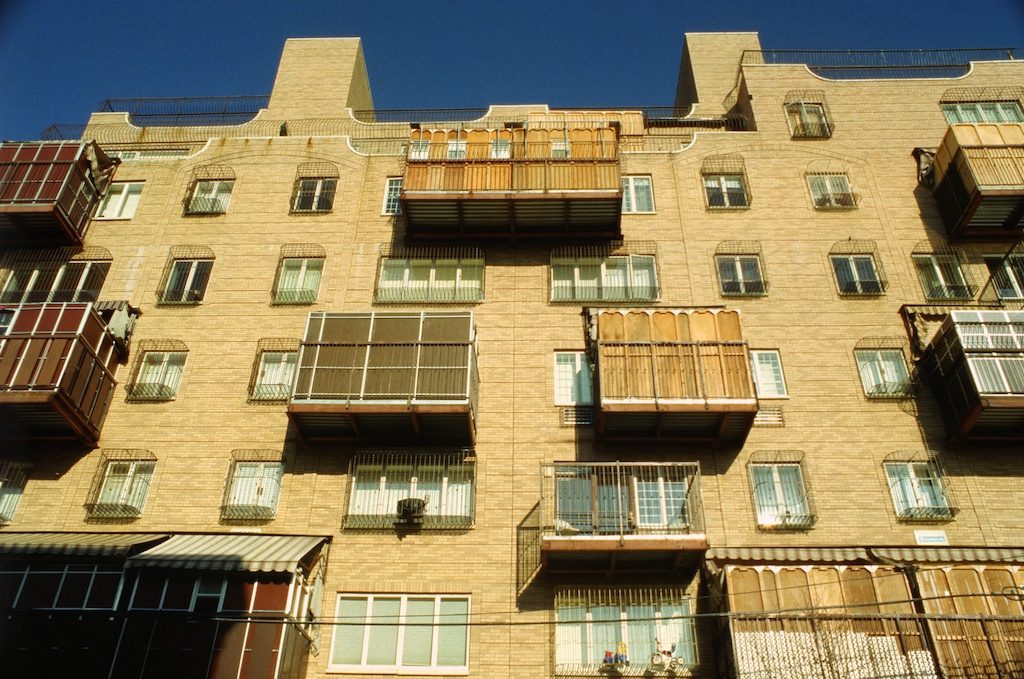
Balconies turned into sukkahs is a common Brooklyn sight in the fall (Source: Alexander Rabb via Flickr Creative Commons)
Autumn is a great season to be in New York. The flux of fall foliage and chilly winds remind us that away from the taxi-strewn streets and skyscrapers there is a world of natural things. We are part of a circle of life that is ripe with significance and, yes, Instagram potential. On many Brooklyn streets the arrival of fall is marked by the sight of strange shacks being erected in small outdoors spaces. Say hello to the Jewish holiday of Sukkot.
One in four residents of Brooklyn is Jewish, according to one local news source. As a result, when the Jewish population celebrates a holiday, the whole borough knows about it. No holiday is more conspicuous than Sukkot, in which an outdoor shelter, called a sukkah, is constructed. In heavy Jewish demographics, like Williamsburg and Borough Park, some blocks strewn with ramshackle tents can start to look like outdoor music festivals.
Sukkot does double-duty as an eight-day long celebration of the harvest and the exodus from Israel. While the holiday focuses on appreciating nature as the source of our food and shelter, in a strange way, it is also a literal celebration of small dwellings, DIY home repair and that classic real estate mantra – location, location, location.
I know, this requires some explanation.
The Meaning of Sukkot
Sukkahs along Eastern Parkway in Crown Heights, Brooklyn (Source: Fran Simo via Flickr Creative Commons)
Sukkot literally means booths. Huh? Digging deeper in to the Hebraic dictionary, another definition surfaces – a fixed or movable habitation, typically of light construction. This refers to the small shacks farmers would erect to stay close to the fields during the harvest season. This allowed them to more efficiently gather crops and not waste time schlepping back and forth between home and field. It also signifies the dwellings used by the Jewish people on their 40-year sojourn throughout the desert in between Egypt and Israel.
Is it just a coincidence that New Yorkers have an almost biblical reverence for housing that allows for mobility and proximity to work? Maybe this should be adopted as an official NYC holiday. It is strangely fitting that in a borough such as Brooklyn, with a dense population, coveted real estate and a healthy appreciation for even the smallest of spaces, we also have one of the highest concentrations of Sukkot on the globe.
DIY sukkahs can be found in Brooklyn (Source: Timothy Krause via Flickr Creative Commons)
How to Build a Sukkah in Brooklyn
Sukkot tradition encourages every household to try building a sukkah from scratch. Even though the sukkah is an ancient, utilitarian structure, there are some rules to building it. According to the Old Testament, these tabernacles must have at least three standing sides. The minimum sizing standards aren’t tough to meet – dimensions of no less than 2 feet by 2 feet, which is the median size of a NYC kitchen. The roof, also known as a S’chach, is the big deal. It must be made of natural substances, severed from the earth, and untouched by metal. It should block most of the sun but still allow the sight of stars. This last part is often the hardest for city dwellers, and not just because of all the light pollution, but also because many Brooklynites who are trying to construct a sukkah are on balconies and porches that obstruct sky views. Many apartment buildings in densely Orthodox neighborhoods are constructed with terraces and balconies that accommodate this provision. Instead of stacking balcony on top of balcony, buildings will feature balconies that are staggered and spaced out. See the image below.
Staggered balconies accommodating many sukkahs in Williamsburg
Where to Buy a Sukkah in Brooklyn
In classic New York fashion, many people opt for delivery. A thriving business sprung up around the construction of the annual Sukkot, for all the New Yorkers who don’t have freshly cut branches lying around or can’t spare the time to weave them into a thatched roof. Many local stores sell a variety of sukkahs that are easy to assemble and cost between $150 and much, much higher. Sukkah Center and Leiter’s Sukkah are two local options that are happy to serve first-timers and veterans alike. Another fee can match you with a contractor to assemble it. But if you have the time what better way can you honor the holiday of the harvest than with some sweat and hard work, followed by dinner al fresco.
Sukkot doesn’t just celebrate questionably sturdy structures (or else IKEA would have already bought the rights.) It also celebrates the full circle of natural resources that allow for the farm, the crops, the shelter and the feast. Whether you identify as Jewish or just dig eating good food with friends in outdoor spaces this is a holiday to partake in. This year during Sukkot don’t walk around the city clueless. Fill your friends in on the temporary structures that herald the fall season.
Related: